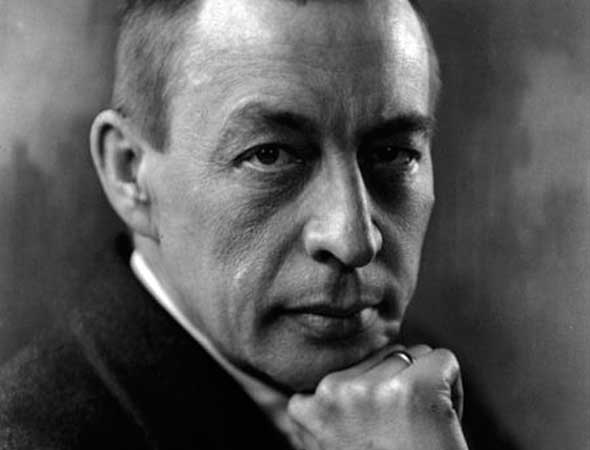RACHMANINOFF – Rhapsody on a Theme of Paganini
Instrumentation: 3 flutes, 3 oboes, 2 clarinets, 2 bassoons; 4 horns, 2 trumpets, 3 trombones, tuba; strings; percussion; solo piano.

Sergei Rachmaninoff
Piano music has its partisans, and according to some, Rachmaninoff was the greatest pianist ever lived. Others vehemently disagree. We will never know who is right, but we can learn from enthusiasts’ speculations and research.
There’s certainly no denying thrilling power and sheer dazzle of Rachmaninoff’s piano works, along with their gloriously lush, unrestrained romanticism. Listeners who cherish great pianism have joined with scholars in rediscovering lost Rachmaninoff piano rolls, reconsidering his recordings, and reevaluating contemporary accounts of his concerts. These reveal not just the pianist of legend with tremendous hands capable of thundering power and speed, but also a poetic, aristocratic interpreter whose subtleties in performance matched the dense layering and structural ingenuity of his compositions.
Which is not to gainsay the appeal of Rachmaninoff’s technical brilliance. In his Rhapsody on a Theme of Paganini we have a perfect convergence of all the elements of instrumental virtuosity: a melodic subject drawn from a violin caprice by Nicolo Paganini, the violinist who helped invent the very idea of the classical virtuoso superstar; an extraordinary set of 24 variations designed to showcase both compositional and performance skills; a heroic expansion of the original melody’s scale and dynamic range; and special attention to Rachmaninoff’s particular gifts as a pianist — the blazing speed and thundering power that thrilled his audiences.
Rachmaninoff was essentially a figure of the 20th century, the last of the Russian romantics. But his sound was rooted in the 1800s and in the Russian nationalist tradition dating back to Glinka and Tchaikovsky. He trained as a performer and composer in Moscow and St. Petersburg, focusing on the piano in both disciplines. But all expectations for his future life, including his life in music, were shattered by the Russian revolution of 1917, when Rachmaninoff’s aristocratic family lost their long-held estate with its traditional way of life. He became a citizen of the United States and died here while touring as a concert pianist, just three days before his 70th birthday.
Rachmaninoff composed the Rhapsody in 1934, when he had already written four full-length concertos, and despite his frequent bouts of self-doubt, he had every reason to be confident of its success and formal excellence. Not just a collection of variations on a theme, the Rhapsody is a concertante that is formally constructed, with the 24 variations dividing themselves into three movements in which most of the variations, like Paganini’s original theme, are stated and developed in A minor. The result closely resembles a concerto with traditional fast, slow and faster movements.
Listeners who cannot quite place the formal title of the Rhapsody will immediately recognize Paganini’s familiar main subject, which is the best-known and -loved of his set of 24 violin caprices. It’s built upon a pair of peppery A-minor phrases that sound vaguely demonic, especially on the violin. The melody starts with an emphatic A, and then, after a quick four-note figure, jumps up to E — then drops an octave to a lower E, repeats the four-note figure starting on E rather than A to arrive back where it began. This basic progression — start on the tonic, jump up a fifth, drop an octave and jump up a fourth to the tonic again — it is often called “circular,” and could be repeated in an endless loop if a counterbalancing phrase didn’t intervene…eventually resolving it on the same tonic note.
In Rachmaninoff’s treatment of this theme, the first ten variations form an opening movement, with another theme — a quotation of the Dies irae theme of the Latin mass — arising in variations 7, 10, 22 and 24. Variation 11 consists of a slow, poetic transition that leads us into a slow movement that moves gradually from D minor to D-flat minor, culminating in the most famous musical interlude in the entire Rhapsody, variation 18. You’ll be lost in the beauties of Rachmaninoff’s lush romanticism when this variation, vernal and ecstatic, soars forth, literally turning the original theme on its head — a direct inversion of Paganini’s original A-minor subject. Understanding its potential popularity, Rachmaninoff is reported to have quipped, “this [variation] is for my agent.” It is often played as a stand-alone work.
But the entire composition, as well, has been popular since its premiere in Baltimore in 1934. When Bruno Walter led the New York Philharmonic in the Rhapsody’s first New York performance, Rachmaninoff was at the keyboard and writer Robert A. Simon commented in The New Yorker that “The Rachmaninoff variations, written with all the composer’s skill, turned out to be the most successful novelty that the Philharmonic Symphony has had since Mr. Toscanini overwhelmed the subscribers with Ravel’s Bolero.”












